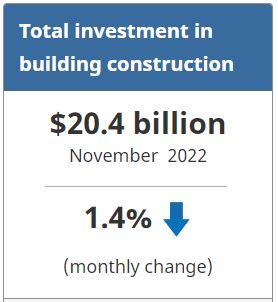Statistics Canada: Investment in Building Construction, November 2022
Investment in building construction declined 1.4% to $20.4 billion in November, with most of the drop coming from Alberta (-5.6%). The residential sector decreased 2.0% to $14.9 billion, while the non-residential sector edged up 0.2% to $5.5 billion.

On a constant dollar basis (2012=100), investment in building construction decreased by 2.0% to $12.0 billion.
Single-family investment continues to fall
In November, investment in residential building construction was down 2.0% to $14.9 billion, the third consecutive decline in this sector. Alberta (-7.1%) experienced its largest drop in residential investment since the COVID-19 downturn in April 2020.
Investment in single-family homes continued to fall for the fourth consecutive month, down 3.9% to $7.8 billion in November, with all provinces reporting declines. This month’s decline brought the single-family component back down to levels last seen in December 2021.
Multi-unit family investment remained relatively unchanged, edging up 0.1% to $7.1 billion, despite notable gains from Manitoba (+16.4%) which helped offset declines in six provinces.
Industrial sector drives gains in non-residential construction
Investment in non-residential construction was up 0.2% to $5.5 billion in November. Ontario (+1.3%) accounted for most of the growth as they led the gains in each component.
Industrial construction investment increased 0.9% to $1.1 billion and was up 25.5% year over year. This was the 12th consecutive monthly increase in this component.
At the subcomponent level, mining and agriculture buildings surpassed pre-pandemic levels, with substantial growth over the previous 12 months (+79.8%). The factories subcomponent has also seen considerable growth, with an increase of 33.8% on an unadjusted basis since November 2021. Conversely, the transportation subcomponent was down 6.3% year over year on an unadjusted basis.
Commercial construction investment edged up 0.1% to $3.1 billion in November 2022 and was up 13.5% year over year.
Institutional construction investment remained flat in the month at $1.4 billion and has stayed around this value after reaching its historic peak in April.
For more information on housing, please visit the Housing statistics portal.
Note to readers
Data are subject to revisions based on late responses, methodological changes and classification updates. Unadjusted data have been revised for the previous two months. Seasonally adjusted data have been revised for the previous three months.
Data presented in this release are seasonally adjusted with current dollar values unless otherwise stated. Using seasonally adjusted data allows month-to-month and quarter-to-quarter comparisons by removing the effects of seasonal variations. For information on seasonal adjustment, see Seasonally adjusted data – Frequently asked questions.
Monthly estimates in constant dollars are calculated using quarterly deflators from the Building Construction Price Index (table 18-10-0135-01). Typically, the first two months of a quarter use the previous quarter’s price level, and the data are revised when the new quarterly price index becomes available.
Detailed data on investment activity by type of building and type of work are now available in the unadjusted current dollar series.
The Trade and Services subcomponent includes buildings such as retail and wholesale outlets, retail complexes and motor vehicle show rooms. More detailed information can be found on the Integrated Metadatabase at Types of Building Structure – 2.2.1 – Trade and services.
Next release
Data on investment in building construction for December 2022 will be released on February 13, 2023.
Products
Statistics Canada has a “Housing Market Indicators” dashboard. This web application provides access to key housing market indicators for Canada, by province and census metropolitan area. These indicators are automatically updated with new information from monthly releases, giving users access to the latest data.
Source: Statistics Canada

